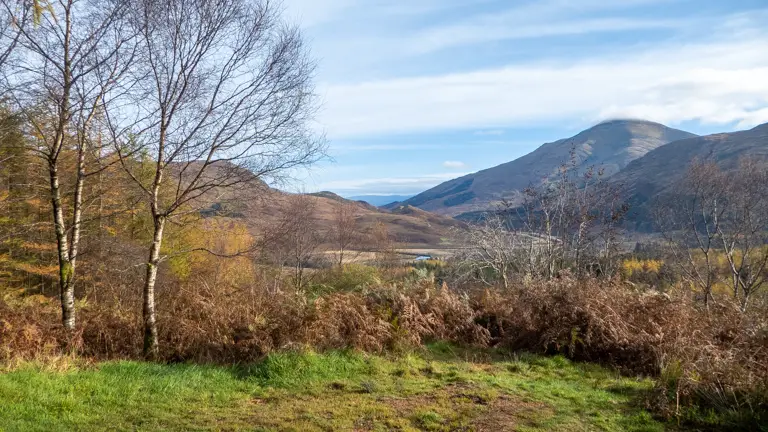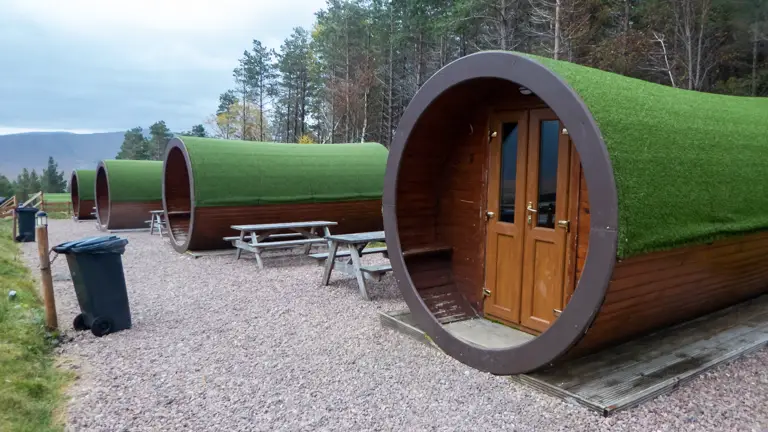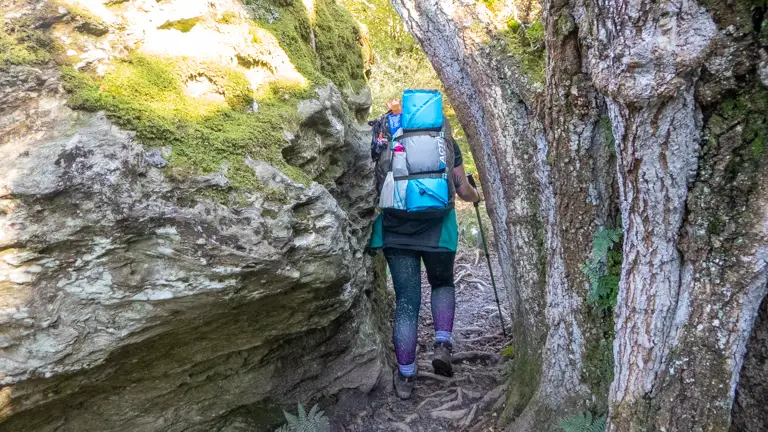The West Highland Way is arguably Scotland’s most popular thru-hike. It begins just outside Glasgow in Milngavie and continues all the way to Fort William, the gateway to the Scottish Highlands. This 96-mile hike can be challenging, especially with the unpredictable Scottish weather. Never fear though, I have put together this insanely helpful West Highland Way packing list so you know exactly what to bring on your adventure, no matter the season!
Before we delve into the nitty-gritty of what made it onto my West Highland Way packing list, we must first talk about what kind of weather to expect when you do your trek. This will be a huge influencer on the things that you need to bring on your journey.
This post may contain affiliate links. If you use them, I will receive a small commission at no extra cost to you.
Read more: (opens in new tab)
- West Highland Way Itineraries
- Camping on the West Highland Way
- West Highland Way Accommodation Guide
- West Highland Way vs. Great Glen Way
What Season Should You Hike the West Highland Way?
Before we delve into what season is best to hike the West Highland Way, it is important to recognise the wildlife which can plague the trail. The highland midge is a tiny flying insect, much like a gnat. Although they are small, they bite, leaving itchy red welts. They are only present certain times of the year in Scotland but when they are at their highest numbers, they can make trekking very uncomfortable. To avoid the worst of these flying nuisances, check out this article about midges in Scotland.

Hiking the West Highland Way requires a bit of planning!
Winter
It is possible to do the West Highland Way walk in winter, however, this is not recommended. The weather is harsh and it is very cold. Snowfall and ice can lead to disruptions along the route and also be dangerous for hikers.
It is important to know that many of the accommodation providers and other services along the route close during the winter as well, which means you could end up out in the cold! As the conditions are so unsuitable for hiking, there is also next to no-one on the trail. This means you will not be able to enjoy the strong sense of community that often characterises long-distance hikes.
Spring
This is a good time to do the West Highland Way hike. The trail is quieter than it is during the summer months and the weather is generally cooler to hike in. Midges generally appear at the start of summer so spring is a good time to hike without the need for smidge and other repellents.
Although April can be a little unpredictable in terms of weather, Scotland should become drier as spring progresses. However, warm sunny days are never guaranteed in these parts!
Summer
This is peak season for hiking the West Highland Way and therefore, the trail will be very crowded. The midges generally arrive towards the end of June and can make evening relaxation and camping on the West Highland Way miserable. Despite these negatives, you are likely to be blessed with warmer weather, although it may be a little wet and drizzly throughout the season.
Autumn
This was the time of year that myself and my boyfriend Tim hiked the West Highland Way. With all the autumn colours, it was a magical experience. Once September and October roll around, the midges are generally on the decline and although temperatures have dropped since the summer months, you are likely to still get a lot of clear days.

As with early spring, the weather can be unpredictable which means rain and high winds. You must prepare for this when packing for the West Highland Way. Bear in mind that because Scotland is so far north, you will begin to lose daylight hours very quickly towards the end of October.
How Many Days Will Your West Highland Way Journey Take?
People complete the West Highland Way trail in anything from 5-10 days. Whilst 5 days is generally not enough time to soak in the scenery (in my opinion), 7 or 8 days provide ample opportunity. Obviously, the longer your trek takes, the more stuff you will need to bring – or the more washing you will need to do!
Camping or Hotels?
Deciding what kind of accommodation you are going to stay in along the trail is hugely important when making your West Highland Way packing list.
Camping along the route is common, especially in the summer, although there are sections of the trail that have a ban on wild camping during certain months. If you are choosing to camp, you must consider the season to determine what kind of gear you need to bring. Read this for more information on camping on the West Highland Way.
If you are trekking during the warmest weather, you may find a basic tarpaulin tent more than meets your needs. However, in autumn you will need something more substantial, in terms of both tent and sleeping bag. Trust me, on that one… I had some very cold nights at the end of October under just a tarp!
Hotels and other accommodation providers are available at regular intervals throughout the trek and vary in price. In some locations, there is little choice which means you may end up paying more than the accommodation would usually be worth. This is probably not the best option for hikers on a shoestring budget. However, this is definitely the way to go if your priority is keeping your bag as light as possible.
Depending on when you choose to walk the West Highland Way, you may need to book accommodation in advance. Rooms in peak season can get filled, up to 6 months in advance!
Baggage Transfer Services: Yay or Nay?
During your West Highland Way hike, it is possible to use a baggage transfer service. This is where you pay a fee to a company and arrange pick-up and drop-off of your baggage at agreed accommodation spots along the route.
All you will be required to carry with you as you hike is a small daypack, full of the essentials. The average cost for a bag being transferred along the entire route is around £45, however, it is possible to get discounted rates if you are in a group and transferring more bags. If you are walking the route in reverse (Fort William – Milngavie), baggage transfer is usually more costly.
I will say that I did not use a baggage transfer companies so am not in a position to recommend any particular one. During my West Highland Way hike, I did a mixture of wild camping and hotel/hostel accommodation so had more to carry than I would ideally have liked. However, as the trek was part of an extended travel itinerary, I decided to save the money I would’ve spent on baggage transfer for other pursuits.
However, you may find using a baggage transfer company suits you and if you have a particularly heavy bag, it is recommended. Walking with an overweight pack is more likely to cause injury and you could be forced to pull off of the trail altogether.
West Highland Way Packing List
Regardless of whether you are camping or hoteling, I have made this West Highland Way kit list to suit all. Simply go through and see what applies to your journey and adapt the numbers accordingly.
Footwear
Okay first things first, let’s start with the most important thing: shoes. Under no circumstances should you attempt to hike the West Highland Way without breaking in your boots or shoes first. You have been warned.
- 1 x pair of hiking boots/shoes/trail runners
- 1 x pair of sandals or flip-flops
- 10000 x blister plasters (Compeed are the best – you can never be too prepared)!
Whilst most people would assume they need a hardy walking boot for this hike, that is not necessarily the case. I used my trusty Mitzi walking boots by Trespass that I also throughout my Camino de Santiago hike. This was an error but not because of the boot choice, just because they were already so worn.
Tim favours trail runners and walking shoes over bulky boots as they are so much quicker to dry out. Because the West Highland Way runs through Scotland (with all of its unpredictable weather), quick-dry shoes are a good shout.
For the evenings, I brought a pair of Karrimor Martinique walking sandals. They would be absolutely no good for long hikes but they allowed my feet to breathe and didn’t take up much space in my backpack. If you are more of a flip-flop kind of person, they would also do the job perfectly.
West Highland Way Hiking Clothes Kit List
- 1 x foldaway rain jacket
- 1 x hiking trousers
- 2 x sports leggings
- 2 x fleeces
- 3 x quick-dry t-shirts
- 2 x base layers
- Underwear
- Socks
- 1 x sports bra
- 1 x normal bra
- 1 x buff/hat
- 1 x hiking poncho
Although you can easily spend a lot of money on a rain jacket, I don’t see much need. You are better off buying a packable coat that compresses down really small. These are lighter to carry, can be hung on the outside of bags and are an all-around great space saver!
It took me a long time to invest in a pair of hiking trousers but they were definitely a good purchase. Mine zip off just below the knee so depending on the weather, they can be worn as trousers or shorts. They are a great item that can be flexible depending on weather and climate.
In my opinion, sports leggings are an absolute must for hiking. If you buy a decent pair, the sweat-wicking fabric will help to keep you cool in all the right places. They also allow you to be more flexible than other trousers (great when you are clambering over stiles)! I recommend the activewear range by Lucy Locket Loves!
I don’t think you need to splash out on an expensive fleece. Although you want something that will keep you warm, generally you want something thin so that is lightweight, easily packed away and easily layered up. I prefer to add more layers to keep warm, hence why you won’t see a bulky coat on this packing list.
Quick-dry t-shirts are an absolute must on any long-distance hike. Whilst I’ve listed three as an ideal number to take, you could get away with packing less if you don’t mind being a bit smelly. No judgement from me, this is what I did!
When hiking in Scotland, it is definitely important to invest in a couple of base layers. Those made from Merino wool are undoubtedly the best, although they are expensive. If you are on a tight budget, maybe take one Merino wool layer and another more basic version.
When it comes to underwear, you want something comfortable. It probably goes without saying but you have at least enough pants for a clean pair every day. Socks should be hiking specific so that they offer thicker material in the areas which are generally prone to blisters. If you can afford a pair of Merino wool socks, they will be a very good investment!
Ladies will find that a sports bra will serve them well on the West Highland Way, but it is still important to bring along a normal bra too. I found that my sports bra wasn’t comfortable to wear around the clock so was glad I had brought a backup!
You will definitely need something to keep your head warm, especially if you hike in spring or autumn. Whilst you could bring a hat, I’d recommend a buff. Use it to keep your neck toasty, tie your hair back or as a sweatband. Both Tim and I favour buffs by Turtlefur as they are light and cosy. The brand Buff also come highly recommended.
Although a lot of trekkers scoff at hiking ponchos, they are a godsend in a downpour! They will cover your backpack and body so whilst you might look a bit of an idiot wearing one, you’ll be glad you made the investment. Mine definitely came in use when I did the Salkantay trek!
West Highland Way Relaxation Clothes Kit List
I won’t lie to you, I didn’t really have much in the way of dedicated relaxation clothes. I had one long, baggy t-shirt/dress from H&M that I wore in dorm rooms and I just used the more clean of my base layers and leggings for when I wild camped. Depending on how much you care about smelling, you may want to take everything on this list or indeed, nothing at all!
- PJ’s or comfortable equivalent
- Comfy socks (just in case the hiking ones got wet)
- T-shirt
- Comfy leggings
Toiletries and Health
- Toothpaste
- Toothbrush
- Deodorant
- Soap
- Shampoo/conditioner (small)
- Smidge midge repellent
- Suncream
- Lip balm
- Tweezers (for ticks)
- Baby wipes
- Painkillers
- Menstrual cup (if necessary)
- Plasters
- Hand sanitiser
- Antiseptic cream
- Nail scissors (For blister surgery)
- Knee/ankle support (It is always best to come prepared)
Camping Equipment
- Lightweight tent/tarp (depending on time of year)
- Bivvy sack
- Sleeping bag
- Inflatable pillow (or use a rolled-up fleece)
- Lighter
- Multi-tool
- Inflatable sleeping pad
- Trowel (for the toilet)
- Spork
I wouldn’t recommend bringing cooking equipment because of the extra weight but prepping sandwiches, pasta and quinoa in advance will help you save some much-needed dollar on the trail. This only really works if you are alternating between organised camping and hosteling. Many of the official campsites have communal cooking facilities that you can use.
Check out my favourite backpacking lunch ideas here.

Electronics
- Portable charger
- Plug-in chargers and cables
- Adaptor (if required)
- Head Torch (For those early starts)
- Camera
- Dry bag for electronics (in case of freak downpour)
- Mobile phone
Long -distance hiking trails are a great opportunity to have a digital detox. However, I preferred to use my mobile phone to lessen the load in my pack. By using an online map, I could forfeit carrying a guidebook. I would definitely recommend the West Highland Way map that you can purchase on the Guthooks app. The West Highland Way actually have their own app too which is fantastic for finding accommodation options and places to eat along the trail.
Miscellaneous
- Durable backpack
- Waterproof bag cover
- Hiking poles
- Plastic bags (for rubbish)
- Toilet paper
- Gaffa tape (for emergencies or very bad blisters)
- Travel towel
- Whistle (also for emergencies)
- Filter water bottle
There are plenty of lochs and streams which you could drink from along the West Highland Way trail. However, you would need a good water filter to do this. Something like the LifeStraw filters out particles and bacteria but the Grayl Geopress goes one step further and also gets rid of viruses.
Final thoughts on packing for the West Highland Way
When it comes to packing for any long-distance hike, less really is more. In my opinion, it is better to be a bit stinky rather than cripple yourself because you are trying to carry an excess amount of clothes. Trust me, when it comes to looking back on the trip, you won’t be thinking about how glad you were that you wore a different outfit every day!


Very nice reading. I’m going to walk WHW myself in a few weeks 🙂
One thing I noticed though was this comment “It probably goes without saying but you have at least enough pants for a clean pair every day”. All or most of the long distance hikers I know of actually just brings 2-3 pairs even for 3 weeks of hiking, sometimes longer. Alternating in between them and/or hand washing once in a while. Merino wool, ofc.
Hi Dennis, thanks for reading!
That’s a fair comment. I probably should have stated that I don’t mean a new pair every day, just enough pairs that I can have some hanging from my pack to dry. Then I’ll have clean ones to put on the following day. I think women tend to be a bit more fussed about clean pants than men as a general rule! While I will limit the number of pairs I take on very long hikes (usually 7 days+), I am happy to sacrifice a bit of pack space to feeling clean on shorter hikes. Just my own personal preference though, I know plenty of people who take fewer pairs than me! I definitely second Merino Wool – my favourite material for hiking! Have a great hike 🙂